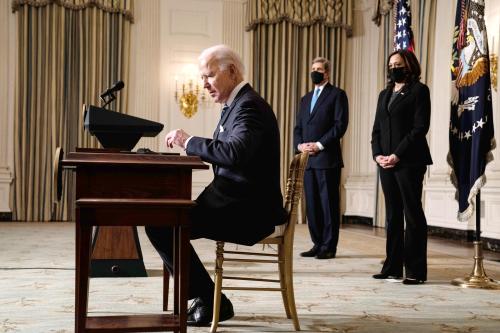On Earth Day, April 22, President Joe Biden hosted a global summit on climate change to emphasize that the United States is back in the game on climate policy and to encourage greater climate ambition among other countries. Just over 100 days into his administration, Biden has largely put his cards on the table in terms of his climate goals and his plans to reach them. The big question is whether he will be able to overcome stiff political challenges on one of his core issues.
The Biden climate commitment
A little background on the Paris Agreement within the United Nations Framework Convention on Climate Change is helpful here. It has a “bring your own goals” structure. Each member country makes a pledge of emissions reductions that it will deliver, called a nationally determined contribution (NDC). The sum of these pledges is the “meat” of the agreement. Pledges submitted in advance of the 2015 agreement were not sufficient to achieve its overall goal — limiting global average temperature rise to less than 2°C, ideally to less than 1.5°C. However, the agreement requires NDC updates every five years with the idea that they will become more ambitious over time, driven by technology improvements and cost reductions, along with peer pressure. Those updated, ideally more ambitious, NDCs are due before the COP26 conference in early November this year.
President Donald Trump pulled the United States out of the Paris Agreement, but Biden rejoined the agreement on his first day in office. Since Biden’s election and inauguration, the new U.S. NDC has been a hot topic of discussion among climate experts and concerned citizens worldwide. And it is finally here, issued on April 21 in advance of the Earth Day Climate Summit. Announcing the NDC provided the Biden administration with an opportunity to demonstrate its commitment to climate action, to domestic voters and the wider world.
In the months since the election, environmentalists have generally agreed that the U.S. NDC needed to be at least a 50% reduction in emissions by 2030 (from a base year of 2005, the peak year for U.S. greenhouse gas emissions). They got their wish — the NDC pledges 50% to 52% reductions from 2005, which totals out to reductions of 39% to 45% from 2020 emissions. But the question I’ve been asking myself is, how? Nine years is a short time for such a profound transformation.
The NDC itself doesn’t have a lot to say about the policies that will be used to achieve reductions, instead describing the sectors with significant emissions and potential ways of abating them. This is normal — the European Union submitted its own NDC in December 2020, but the implementation plan is still under consideration and expected to be issued in June. (The U.S. NDC is less ambitious than the EU’s, which promises similar percent emissions reductions, but from the smaller baseline of 1990.)
Several studies, including from the University of Maryland Center for Global Sustainability, the Environmental Defense Fund, and the Asia Policy Institute and Climate Analytics, describe how the U.S. could achieve the level of reductions pledged in the NDC. The plans describe different combinations of policy mechanisms, but demonstrate that the pledged reduction is achievable — albeit very challenging.
Unlike in the European Union, a nationwide price on carbon is off the table for now. A carbon price, through a tax or a cap and trade program, would require legislation from Congress. And such legislation has no chance of passing the current Congress. Without a price on carbon, sector-specific policies must carry the burden of reducing emissions.
Sectoral emissions reductions
For the most part, the Biden administration has already proposed the programs it plans to use to achieve the emissions reductions pledged in the U.S. NDC. The American Jobs Plan that the White House issued on March 31 is the closest thing to a “climate bill” we’re likely to see before the 2022 midterm elections. It contains a number of elements that would contribute to significant emissions reductions. Additional reductions are likely to come from programs that the administration can implement on its own, without Congress.
The electricity sector is the second largest source of U.S. greenhouse gas emissions, constituting 25%, and the largest area of emissions reductions in every analysis I’ve seen. President Biden set a goal of a carbon-free electricity system by 2035 and the American Jobs Plan sets a path toward that goal with a clean electricity standard, tax credits for zero-carbon electricity and power storage, and investment in the transmission capacity needed to modernize and reshape the U.S. electricity grid.
The transportation sector is the largest source of U.S. greenhouse gas emissions at 29%, but is more difficult to decarbonize than electricity. Nonetheless, significant reductions from transportation are needed in any plan to achieve the U.S. NDC. Policy focuses on vehicle electrification, which will steadily reduce emissions as the electricity supply decarbonizes. Light vehicles are the easiest type to electrify, and the American Jobs Plan focuses on programs to overcome the chicken-and-egg challenge of electric vehicle adoption — consumers won’t buy vehicles without more charging stations, but building charging infrastructure isn’t profitable until there are more electric vehicles on the road. The American Jobs Plan proposes supporting the construction of 500,000 charging stations, making electric vehicles more affordable through rebates and tax incentives, and purchasing electric vehicles for the federal fleet. Reduction in vehicle miles traveled through investments in transit and cycling infrastructure are also included. In addition to policies included in the American Jobs Plan, the Biden administration has also promised to deliver stronger vehicle fuel economy standards by the end of July 2021. The administration has the authority to take this step without Congress, under existing law.
Studies demonstrating how the United States could reduce emissions rely on a variety of other programs for the remaining emissions reductions (around one-quarter of the total) still needed after electricity and transport. Greenhouse gases other than carbon dioxide are 20% of U.S. emissions (on a carbon-dioxide equivalent basis, since these gases tend to be much more potent in their warming potential). Congress is providing help here, as the Senate has already voted to use the Congressional Review Act to reinstate Obama-era regulations on methane emissions, and the House is likely to follow. The Environmental Protection Agency has also announced a rule sharply cutting emissions of hydrofluorocarbons (HFCs), potent greenhouse gases used as refrigerants. Congress already agreed to these cuts at the end of 2020. The American Jobs Plan describes programs to retrofit buildings for energy efficiency, research clean industrial processes, and increase natural carbon sinks like forests.
The legislation challenge
Although the administration has a plan to sharply cut greenhouse gas emissions, success is still far from certain. Cuts in methane and HFCs already approved by Congress have broad support in the regulated industries. Increasing vehicle efficiency standards also has a relatively clear path to implementation. But the American Jobs Plan is already facing Republican opposition, even before it has been written into a bill, part of Republicans’ larger intransigence on climate. Most of the provisions involve tax credits or government spending, the kind of actions that can be passed in the Senate through budget reconciliation with 50 votes plus Vice President Kamala Harris breaking a tie. Secretary of Energy Jennifer Granholm stated that she believes a clean electricity standard could also be passed through reconciliation. However, reconciliation would require all 50 Democratic senators to stick together — and Senator Joe Manchin of West Virginia has already said that he does not support passing legislation in this way — or for at least one Senate Republican to cross the aisle.
President Biden has come a long way in a short time in formulating his climate goals and policy. Studies suggest the goals are very ambitious, but potentially achievable and that the most important obstacles are political. Congressional Republicans might be able to find something to like in supporting popular technologies, like clean energy or electric vehicles, but so far, that’s not happening.
The Brookings Institution is committed to quality, independence, and impact.
We are supported by a diverse array of funders. In line with our values and policies, each Brookings publication represents the sole views of its author(s).











Commentary
Barriers to achieving US climate goals are more political than technical
May 10, 2021